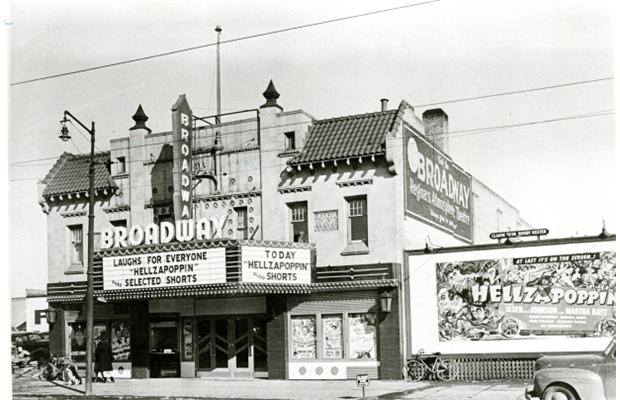Buildings
Broadway Theatre
| Address: | 1773 Broad Street, Regina, Saskatchewan |
|---|---|
| Architects: | Max Zev Blankstein |
| Contractors: | Thos. Barnard |
More Information
The Broadway Theatre opened December 31st, 1929. It was the first theatre in Regina purpose-built for talkies. The theatre was designed by notable Winnipeg architect Max Zev Blankstein, who had built several theatres across the prairies for Jewish theatre owners. The owner of the Broadway Theatre, H. A. Bercovitch, closed the theatre in 1932, only two years after opening, and it only reopened in 1942. He continued to run the theatre until his retirement in 1954. The theatre was sold to Famous Players in 1969, and closed in 1981. It has since been demolished.
Design Characteristics
| Developer: | H. A. Bercovitch |
|---|
- Typical of Max Blankstein, the Broadway Theatre was built in the atmospheric theatre style. The interior of the theatre was designed in the style of a Spanish village, with trees and shrub-adorned in the balconies. A novel feature was a open fireplace inside the lobby. The roof was painted blue, and detailed with reflective stars. A Brenograph Junior machine could be used to project clouds onto the ceiling.
- The Broadway Theatre was built with a seating capacity of 825 people.
- The exterior of the theatre bares a strong resemblance to the Roxy Theatre in Yorkton Saskatchewan, and the Roxy Theatre in Saskatoon, Saskatchewan, both designed by Blankstein for Nathan Rothstein, and built in 1928 - 1929.
- The exterior of the Broadway Theatre is built in the Mission Revival-style, similar to it's sister theatres in Yorkton and Saskatoon, Saskatchewan.
- Clay shingles, set at a steep angle, adorn both sides of roof, with an extravagant parapet running along the centre. Pointed onion bulb-shaped finals sit atop the parapet.
- Dentilled eaves, mouldings around the windows, and separate illuminated signs inscribed "BROADWAY" (one along the centre of the facade, another atop the canopy) make for the cluttered but exciting facade.
- The door handles, angled in a zig-zag across the entrance, offers a small glimpse of art-deco design.



